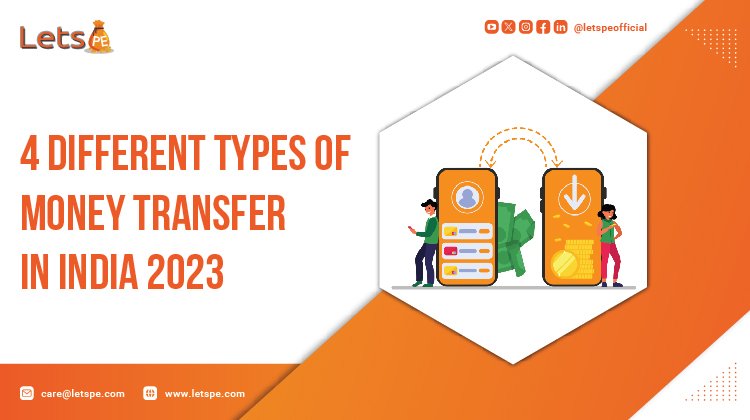4 Different Types Of Money Transfer In India 2023
India's journey towards a digital frugality has been nothing short of extraordinary. There are 4 Different Types Of Money Transfer In India 2023. Unified Payments Interface( UPI), Mobile Wallets.

India has noticed a marvellous transformation in the way money is transferred once many over. The digital revolution, united with government moves like Digital India and UPI(Unified Payments Interface), has converted the financial geography of the country. In 2023, there will be numerous accessible and secure ways to transfer plutocrats in India. In this blog, we will know about the four different types of money transfer methods that are creating new payment revolutions in the country.
Unified Payments Interface( UPI)

In a world that is fast developing towards digitalization, India has appeared as a front- runner in the race to review financial deals. One of the most life-changing developments in this royalism is the Unified Payments Interface( UPI). This innovative payment system has not only accounted for fiscal deals but has also played an important part in encouraging a cashless providence in the country.
Unified Payments Interface, generally known as UPI, has become a house name in India. Developed by the Payments Corporation of India (NPCI), UPI authorises individuals to transfer money incontinently using their smartphones. It has achieved huge fashionability due to its simplicity, security, and versatility across different banks and fiscal institutions.
To use UPI, you need to link your bank account to a UPI- enabled app, similar to Google Pay, PhonePe, or Paytm. After you link your account, you can transfer money to anyone by entering their UPI ID or surveying a QR law. The real-time fund transfer, 24/7 facility, and capability to pay mileage bills make UPI one of the most demanded money transfer methods in India.
Mobile Wallets
India's journey towards a digital frugality has been nothing short of extraordinary, with revolutions like the Unified Payments Interface( UPI) and mobile wallets at the vanguard of this metamorphosis. Mobile Wallets, also known as digital wallets, have gained huge fashionability as an accessible and secure system of making payments and deals and elaboration of Mobile Wallets in India.
Evolution of Mobile Wallets in India
Mobile Wallets first made their presence felt in India around 2010. Companies like Paytm and MobiKwik were among the early discoverers, furnishing a simple way for people to store money digitally on their smartphones and make payments for numerous services. You can charge your wallets with finances using various methods, similar as credit cards, debit cards, UPI, or net banking. Over time, mobile wallets have evolved remarkably to offer a wide range of features beyond just payments, including mobile recharges, bill payments, online shopping, and indeed investments.
Read More - What's the Future of UPI Payments in India?
Mobile wallets offer numerous advantages, similar as abatements, cashback offers, and the capacity to pay for a vast range of services, including online shopping, groceries, and indeed hack lifts.They also support money transfers from one person to another between wallet user people, making them a fabulous choice for quick and trouble-free deals.
Online Banking
In India, online banking is still the primary means of transferring plutocrats. This service is offered by banks and other fiscal institutions. Internet banking permits guests to pierce their accounts, transfer finances, pay bills, and control their finances from the comfort of their homes or services.
To use online banking services, you need to register for internet banking services with your bank and link your account. Online banking provides a vast range of services, including NEFT (National Electronic finances Transfer), RTGS (Real- Time Gross Settlement), and IMPS( Immediate Payment Service). These installations cater to colourful sale requirements, from small diurnal transfers to large-scale deals, and are considered veritably safe and reliable.
Aadhaar Enabled Payment System( AEPS)

The Aadhaar Enabled Payment System( AEPS) is a special money transfer system in India that uses the Aadhaar biometric system. With AEPS, people can pierce their bank accounts and perform deals using their Aadhaar number and point verification. This system is particularly salutary for those in pastoral and remote areas who may not have easy access to traditional banking institutions.
AEPS supports services like cash pullout, balance inquiry, and fund transfers. It has played an important part in financial addition sweats, guarantees that indeed the underbanked and unbanked populations can pierce fiscal banking services.
Conclusion
In 2023, India gave a variety of money transfer options, feeding to the changing requirements and preferences of its citizens. From traditional banking to digital wallets, UPI, and indeed AEPS, individuals have much further choices than ever ahead when it comes to controlling their finances and transferring money. As technology continues to grow, we can anticipate further inventions in the fiscal sector, making money transfers indeed lighter, more effective, and more secure for all. It's important to stay anxious of the rearmost developments and elect the system that stylish fits your specific requirements and terrain.












